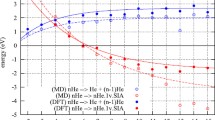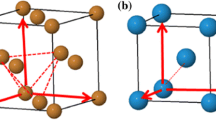Abstract
We investigated the influence of hydrogen (H) on the stability and mobility of small vacancy clusters in tungsten (W) using the first-principles calculations. It is found that the presence of H not only increases the binding energy of small vacancy clusters but also changes their most favorable configurations, owing to the strong attractive interaction between H and vacancies in W. Specifically, the binding energy of di-vacancy changes from negative to positive when the H atoms are introduced. These results suggest that the H addition can significantly promote the stability of small vacancy clusters in W. More importantly, although the migration energy barriers of H-vacancy (H-V) complexes are slightly higher than that of pure vacancy clusters, the activation energy required for complexes migration is always lower than that for dissociation. Therefore, contrary to the conventional view, the collaborative motion of H and small vacancy clusters is possible, because of the low migration energy barriers. Based on the energetic results obtained by first-principles calculations, the mean lifetime and mean diffusion distance of small H–V complexes at different temperatures are examined by the object kinetic Monte Carlo simulations. The small H–V complexes are found to be stable and mobile at moderate temperature, and thus may affect the co-evolution of H and vacancies. These results shed light on the important role of H on the vacancy behaviors and provide a good reference for understanding the defects evolution in W.









Similar content being viewed by others
References
Pitts RA, Carpentier S, Escourbiac F, Hirai T, Komarov V, Lisgo S, Kukushkin AS, Loarte A, Merola M, Sashala Naik A, Mitteau R, Sugihara M, Bazylev B, Stangeby PC. A full tungsten divertor for ITER: physics issues and design status. J Nucl Mater. 2013;438:S48.
Hirai T, Escourbiac F, Carpentier-Chouchana S, Fedosov A, Ferrand L, Jokinen T, Komarov V, Kukushkin A, Merola M, Mitteau R, Pitts RA, Shu W, Sugihara M, Riccardi B, Suzuki S, Villari R. ITER tungsten divertor design development and qualification program. Fusion Eng Des. 2013;88(9–10):1798.
Fang X, Kreter A, Rasinski M, Kirchlechner C, Brinckmann S, Linsmeier C, Dehm G. Hydrogen embrittlement of tungsten induced by deuterium plasma: insights from nanoindentation tests. J Mater Res. 2018;33(20):3530.
Ye MY, Kanehara H, Fukuta S, Ohno N, Takamura S. Blister formation on tungsten surface under low energy and high flux hydrogen plasma irradiation in NAGDIS-I. J Nucl Mater. 2003;313:72.
Shu WM, Wakai E, Yamanishi T. Blister bursting and deuterium bursting release from tungsten exposed to high fluences of high flux and low energy deuterium plasma. Nucl Fusion. 2007;47(3):201.
Roth J, Tsitrone E, Loarte A, Loarer T, Counsell G, Neu R, Philipps V, Brezinsek S, Lehnen M, Coad P, Grisolia C, Schmid K, Krieger K, Kallenbach A, Lipschultz B, Doerner R, Causey R, Alimov V, Shu W, Ogorodnikova O, Kirschner A, Federici G, Kukushkin A. Recent analysis of key plasma wall interactions issues for ITER. J Nucl Mater. 2009;390–391:1.
Tokunaga K, Baldwin MJ, Doerner RP, Noda N, Kubota Y, Yoshida N, Sogabe T, Kato T, Schedler B. Blister formation and deuterium retention on tungsten exposed to low energy and high flux deuterium plasma. J Nucl Mater. 2005;337–339:887.
Oya Y, Li X, Sato M, Yuyama K, Zhang L, Kondo S, Hinoki T, Hatano Y, Watanabe H, Yoshida N, Chikada T. Thermal desorption behavior of deuterium for 6 MeV Fe ion irradiated W with various damage concentrations. J Nucl Mater. 2015;461:336.
Sand AE, Dudarev SL, Nordlund K. High-energy collision cascades in tungsten: dislocation loops structure and clustering scaling laws. Europhys Lett. 2013;103(4):46003.
Mansur LK. Void swelling in metals alloys under irradiation: an assessment of the theory. Nucl Technol. 2017;40(1):5.
Ackland G. Controlling radiation damage. Mater Sci. 2010;327(5973):1587.
Hu X, Koyanagi T, Fukuda M, Katoh Y, Snead LL, Wirth BD. Defect evolution in single crystalline tungsten following low temperature and low dose neutron irradiation. J Nucl Mater. 2016;470:278.
Hu X, Koyanagi T, Fukuda M, Kumar NAPK, Snead LL, Wirth BD, Katoh Y. Irradiation hardening of pure tungsten exposed to neutron irradiation. J Nucl Mater. 2016;480:235.
Li YG, Zheng QR, Wei LM, Zhang CG, Zeng Z. A review of surface damage/microstructures and their effects on hydrogen/helium retention in tungsten. Tungsten. 2020;2(1):34.
Liu LX, Li XC, Chen YC, Hu WY, Luo GN, Gao F, Deng HQ. Evaluation of tungsten interatomic potentials for radiation damage simulations. Tungsten. 2020;2(1):3.
Li ZZ, Li YH, Terentyev D, Castin N, Bakaev A, Bonny G, Yang Z, Liang L, Zhou HB, Gao F, Lu GH. Investigating the formation mechanism of void lattice in tungsten under neutron irradiation: from collision cascades to ordered nanovoids. Acta Mater. 2021;219: 117239.
Causey RA, Venhaus TJ. The use of tungsten in fusion reactors: a review of the hydrogen retention and migration properties. Phys Scr. 2001;T94(1):9.
Hodille EA, Markelj S, Schwarz-Selinger T, Založnik A, Pečovnik M, Kelemen M, Grisolia C. Stabilization of defects by the presence of hydrogen in tungsten: simultaneous W-ion damaging and D-atom exposure. Nucl Fusion. 2019;59(1): 016011.
Pečovnik M, Markelj S, Kelemen M, Schwarz-Selinger T. Effect of D on the evolution of radiation damage in W during high temperature annealing. Nucl Fusion. 2020;60(10): 106028.
Pečovnik M, Hodille EA, Schwarz-Selinger T, Grisolia C, Markelj S. New rate equation model to describe the stabilization of displacement damage by hydrogen atoms during ion irradiation in tungsten. Nucl Fusion. 2020;60(3): 036024.
Markelj S, Schwarz-Selinger T, Pečovnik M, Založnik A, Kelemen M, Čadež I, Bauer J, Pelicon P, Chromiński W, Ciupinski L. Displacement damage stabilization by hydrogen presence under simultaneous W ion damage and D ion exposure. Nucl Fusion. 2019;59(8): 086050.
Li YH, Zhou HB, Gao F, Lu G, Lu GH, Liu F. Hydrogen induced dislocation core reconstruction in bcc tungsten. Acta Mater. 2022;226: 117622.
Heinola K, Djurabekova F, Ahlgren T. On the stability and mobility of di-vacancies in tungsten. Nucl Fusion. 2018;58(2): 026004.
Becquart CS, Domain C. Ab initio calculations about intrinsic point defects and He in W. Nucl Instrum Methods Phys Res Sect B. 2007;255(1):23.
Muzyk M, Nguyen-Manh D, Kurzydłowski KJ, Baluc NL, Dudarev SL. Phase stability, point defects, and elastic properties of W–V and W–Ta alloys. Phys Rev B. 2011;84(10): 104115.
Nguyen-Manh D, Horsfield AP, Dudarev SL. Self-interstitial atom defects in bcc transition metals: group-specific trends. Phys Rev B. 2006;73(2): 020101.
Kato D, Iwakiri H, Morishita K. Formation of vacancy clusters in tungsten crystals under hydrogen-rich condition. J Nucl Mater. 2011;417(1–3):1115.
Li ZZ, Li YH, Ren QY, Ma FF, Yue FY, Zhou HB, Lu GH. Strain dependence of energetics and kinetics of vacancy in tungsten. Materials. 2020;13(15):3375.
Huang GY, Juslin N, Wirth BD. First-principles study of vacancy, interstitial, noble gas atom interstitial and vacancy clusters in bcc-W. Comput Mater Sci. 2016;123:121.
Becquart CS, Domain C, Sarkar U, DeBacker A, Hou M. Microstructural evolution of irradiated tungsten: ab initio parameterisation of an OKMC model. J Nucl Mater. 2010;403(1–3):75.
Mason DR, Nguyen-Manh D, Becquart CS. An empirical potential for simulating vacancy clusters in tungsten. J Phys Condens Matter. 2017;29(50): 505501.
Kong XS, Wang S, Wu X, You YW, Liu CS, Fang QF, Chen JL, Luo GN. First-principles calculations of hydrogen solution and diffusion in tungsten: temperature and defect-trap** effects. Acta Mater. 2015;84:426.
Liu YL, Zhang Y, Zhou HB, Lu GH, Liu F, Luo GN. Vacancy trap** mechanism for hydrogen bubble formation in metal. Phys Rev B. 2009;79(17): 172103.
Ohsawa K, Eguchi K, Watanabe H, Yamaguchi M, Yagi M. Configuration and binding energy of multiple hydrogen atoms trapped in monovacancy in bcc transition metals. Phys Rev B. 2012;85(9): 094102.
Middleburgh SC, Voskoboinikov RE, Guenette MC, Riley DP. Hydrogen induced vacancy formation in tungsten. J Nucl Mater. 2014;448(1–3):270.
Heinola K, Ahlgren T, Nordlund K, Keinonen J. Hydrogen interaction with point defects in tungsten. Phys Rev B. 2010;82(9): 094102.
Kresse G, Hafner J. Ab initio molecular dynamics for liquid metals. Phys Rev B Condens Matter. 1993;47(1):558.
Furthmuller GKJ. Efficient iterative schemes for ab initio total-energy calculations using a plane-wave basis set. Phys Rev B. 1996;54(16):11169.
Blochl PE. Projector augmented-wave method. Phys Rev B Condens Matter. 1994;50(24):17953.
John PP, Kieron B, Matthias E. Generalized gradient approximation made simple. Phys Rev Lett. 1996;77(18):3865.
Monkhorst HJ, Pack JD. Special points for Brillouin-zone integrations. Phys Rev B. 1976;13(12):5188.
Gregory M, Hannes J, Gregory KS. Reversible work transition state theory: application to dissociative adsorption of hydrogen. Surf Sci. 1995;324:305.
Domain C, Becquart CS, Malerba L. Simulation of radiation damage in Fe alloys: an object kinetic Monte Carlo approach. J Nucl Mater. 2004;335(1):121.
Martin-Bragado I, Borges R, Balbuena JP, Jaraiz M. Kinetic Monte Carlo simulation for semiconductor processing: a review. Prog Mater Sci. 2018;92:1.
Martin-Bragado I, Rivera A, Valles G, Gomez-Selles JL, Caturla MJ. MMonCa: an object kinetic Monte Carlo simulator for damage irradiation evolution and defect diffusion. Comput Phys Commun. 2013;184(12):2703.
You YW, Li D, Kong XS, Wu X, Liu CS, Fang QF, Pan BC, Chen JL, Luo GN. Clustering of H and He, and their effects on vacancy evolution in tungsten in a fusion environment. Nucl Fusion. 2014;54(10): 103007.
Samolyuk GD, Osetsky YN, Stoller RE. Properties of vacancy complexes with hydrogen and helium atoms in tungsten from first principles. Fusion Sci Technol. 2016;71(1):52.
Hou J, Kong XS, Wu X, Song J, Liu CS. Predictive model of hydrogen trap** and bubbling in nanovoids in bcc metals. Nat Mater. 2019;18(8):833.
Heinola K, Djurabekova F, Ahlgren T. On the stability and mobility of di-vacancies in tungsten. Nucl Fusion. 2018;58(2):026004.
Ren QY, Li YH, Zhou HB, Li ZZ, Cheng L, Lu GH. Characterization of the energetics and configurations of hydrogen in vacancy clusters in tungsten. Nucl Fusion. 2019;59(10): 106032.
Hayward E, Fu CC. Interplay between hydrogen and vacancies inα-Fe. Phys Rev B. 2013;87(17): 174103.
Boda A, Sk MA, Shenoy KT, Mohan S. Diffusion, permeation and solubility of hydrogen, deuterium and tritium in crystalline tungsten: first principles DFT simulations. Int J Hydrogen Energy. 2020;45(53):29095.
Heinola K, Ahlgren T. Diffusion of hydrogen in bcc tungsten studied with first principle calculations. J Appl Phys. 2010;107(11): 113531.
Mundy JN, Ockers ST, Smedskjaer LC. Vacancy migration enthalpy in tungsten at high temperatures. Philos Mag A. 1987;56(6):851.
Acknowledgements
This work was financially supported by the National Natural Science Foundation of China with Grant Nos. 11905135 and 12075022, the Major Program of National Natural Science Foundation of China with Grant No. 12192281, and the National MCF Energy R&D Program with Grant No. 2018YFE0308103.
Author information
Authors and Affiliations
Corresponding authors
Ethics declarations
Conflict of interest
The authors declare no conflict of interest.
Additional information
Publisher's Note
Springer Nature remains neutral with regard to jurisdictional claims in published maps and institutional affiliations.
Rights and permissions
About this article
Cite this article
Huang, HX., Li, YH., Li, ZZ. et al. Role of hydrogen in stability and mobility of vacancy clusters in tungsten. Tungsten 4, 219–230 (2022). https://doi.org/10.1007/s42864-022-00151-8
Received:
Revised:
Accepted:
Published:
Issue Date:
DOI: https://doi.org/10.1007/s42864-022-00151-8




